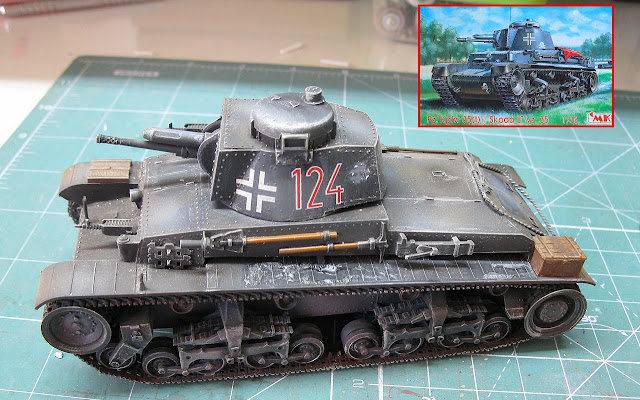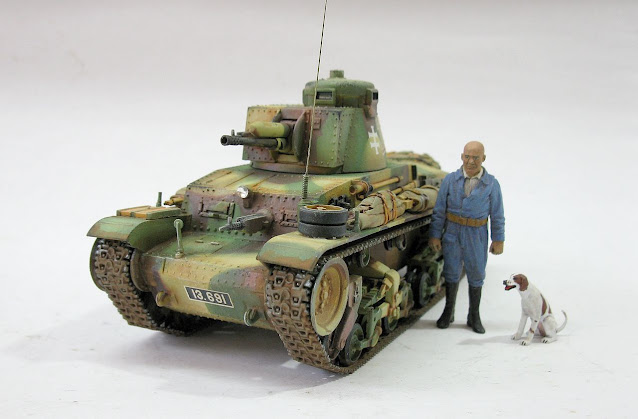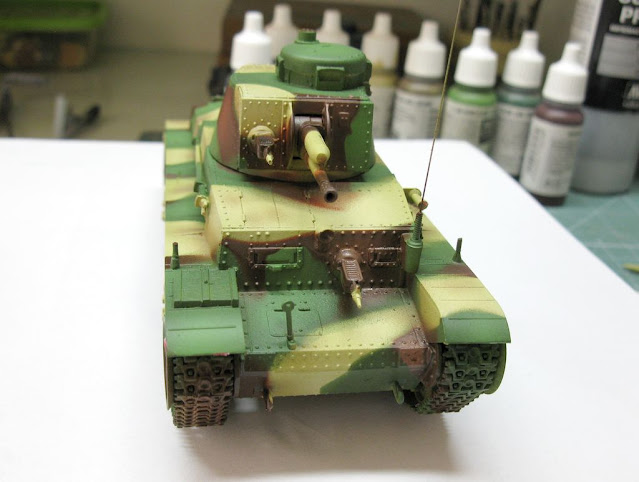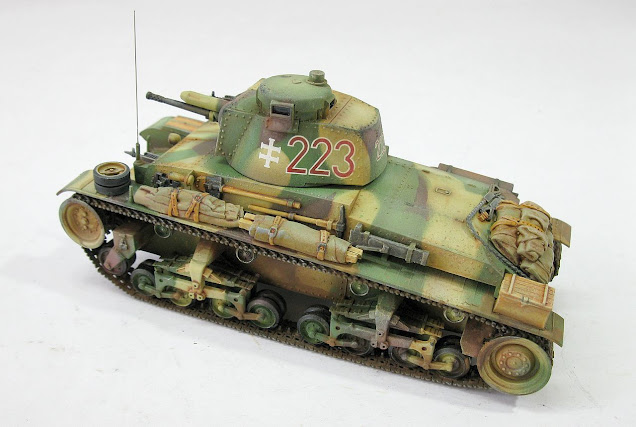Vojáci !!!
Soldiers!!!
Let me introduce to you a lightweight and powerful girl, made in Czechoslovakia, who fought bravely under many flags and on many fronts.
It's time to meet the brave Skoda LT vz.35 Czech light tank.
 |
| Skoda LT vz.35 Czech light tank |
History:
The Skoda LT vz.35 had the formal designation Lehký tank vzor 35 (Light Tank Model 35), but was commonly referred to as the LT vz. 35 or LT-35.
A total of 434 were built; of these, the Germans seized 244 when they occupied Bohemia-Moravia in March 1939 and the Slovaks acquired 52 when they declared independence from Czechoslovakia at the same time. Others were exported to Bulgaria and Romania. In German service, it saw combat during the early years of World War II, notably the Invasion of Poland, the Battle of France and the invasion of the Soviet Union before being retired or sold off in 1942. It was used for the remainder of the war by other countries and as a training tank in Bulgaria into the 1950s.
The Czech Army formulated a requirement in the II-a category of light cavalry tanks by the end of 1934. Českomoravská Kolben-Daněk (CKD) proposed an improved version of its P-II light tank already in service as the LT vz. 34, but Škoda offered a new design that used the pneumatic system and engine earlier proved by its unsuccessful SU or S-II light tank prototype.
One prototype was ordered from each company for delivery during the summer of 1935. Both tanks had the same armament and three-man crew, but ČKD's P-II-a was much smaller at 8.5 tonnes and had only a maximum 16 mm of armour while Škoda's S-II-a weighed 10.5 tonnes and had 25 mm of armour. The army thought that P-II-a was at the limit of its development while the S-II-a could be improved as needed.
 |
| CKD P-II-a - prototype |
 |
| Škoda's S-II-a - winner prototype Future LT vz. 35s |
The first production order for 160 LT vz. 35s, as the S-II-a was designated in Army service, was placed on 30 October 1935 and deliveries began in December 1936. An additional order for 35 was made on 12 May 1936 and a follow-on order placed for 103 more a month later. The total order for 298 tanks was split equally by Škoda Works and ČKD according to their cartel agreement. Development was rushed and there were many defects in the LT vz. 35s. Many tanks had to be returned to the factories to be repaired. Most of these repairs involved the electrical system, not the complicated pneumatic system.
For tank description, foreign interest and variants, see in this Bunker the complete article about these girls, in the Pz.Kpfw 35(t0 article.
 |
| LT vz .35 in working condition Army Technical Museum - Lesany, Czech Republic |
Operational history:
Czechoslovakia
The prototype was forced to retreat into Romania by 17 March, along with most of the other Czech troops in eastern Ruthenia. The Romanians returned the prototype to Škoda six months later.
Slovakia:
Czechoslovakia
The 298 LT vz. 35 tanks were assigned to the armoured regiments belonging to the four Mobile (Rychlá) Divisions between 1936 - 39. Each regiment was supposed to detach three-tank platoons to support the infantry divisions and border areas in times of crisis. These platoons were heavily used suppressing the protests and violence instigated by Konrad Henlein's Sudeten German Party (Sudetendeutsche Partei - SdP) and the Sudetendeutsche Freikorps (paramilitary groups trained in Germany by SS-instructors) between May and October 1938.
 |
| LT vz. 35 Czech light tank in trials 3rd Assault Vehicle Regiment Central Slovakia - 1937. |
After the Munich Agreement, two tank battalions were sent to reinforce the 3rd Mobile Division in Slovakia. They were used to repel Hungarian and Polish border-crossers, sometimes up to a battalion in strength. They screened the infantry when they had to evacuate southern Slovakia after the First Vienna Award on 2 November 1938.
The S-II-a prototype and one LT vz. 35 tank were returning from testing in the Soviet Union when the fighting began. They detrained in Sevljus and participated in a counterattack at Fančíkovo, but the LT vz. 35 was damaged and captured by the Hungarians.
 |
| The LT vz. 35 captured by the Hungarians. |
Slovakia:
The Slovak Army seized 52 LT vz. 35 tanks when they declared their independence from Czechoslovakia in March 1939. They were organized into a battalion that was later incorporated into the Armoured Regiment. Three of these tanks participated in the Slovak-Hungarian War of March 1939. One tank company participated in the invasion of Poland, but didn't see any fighting. The Army upgraded the internal communications system of its tanks with German intercoms in 1941, but it is unknown if they added a fourth crewman as did the Germans. When Slovakia joined the German invasion of the Soviet Union it sent a Mobile Group that included thirty LT vz. 35.
The Mobile Group was reinforced and reorganized in early July 1941 as the Mobile Brigade, also known as Brigade Pilfousek after its commander, and it mustered only twenty seven tanks despite seven reinforcements because breakdowns had caused ten to be evacuated back to Slovakia. This was due to a conspiracy among the Slovak tankers that the tanks would be needed to overthrow the regime at some point and couldn't be wasted in combat against the Soviets.
This caused a high incidence of crew sabotage to which the officers and maintainers turned a blind eye, which caused the tanks to be withdrawn to Slovakia at the beginning of August 1941. On 1 January 1942, the Slovaks had 49 LT vz. 35 on hand because three had been destroyed in the battle for Lipovec earlier in the summer. However, of these 49 only seven were operational as part of the conspiracy to keep the tanks in Slovakia. The LT vz. 35s were relegated to the training/reserve role by 1943 when the Germans began to supply more modern tanks to Slovakia. At least eight LT vz. 35s were used by the insurgents during the Slovak National Uprising in 1944.
Specs:
| Skoda LT vz.35 Czech light tank | |
|---|---|
| Type | Light tank |
| Place of origin | Czechoslovakia |
| Service history | |
| In service | 1936–50? |
| Used by |
|
| Wars | World War II |
| Production history | |
| Designer | Škoda |
| Designed | 1934–36 |
| Manufacturer | Škoda, ČKD |
| Produced | 1936–40 |
| No. built | 434 |
| Variants | T-11, R-2c, TACAM R-2 |
| Specifications | |
| Weight | 10.5 t |
| Length | 4.90 m |
| Width | 2.06 m |
| Height | 2.37 m |
| Crew | 3 |
Main armament
| Škoda ÚV vz.34 - 37 mm (1.46 in), 72 rounds |
Secondary armament
| 2 x 7.92 mm (0.31 in) Zbrojovka Brno vz.37 machineguns, 1800 rounds |
| Engine | 4-cylinder, water-cooled Škoda T11/0 gasoline 120 hp (89 kW) |
| Power/weight | 11 hp/tonne |
| Transmission | 6 x 6 |
| Suspension | leaf spring |
| Fuel capacity | 153 |
Operational range
| 120 km or 190 km |
| Speed | 34 km/h |
The kit:
This is a is a typical recycling project for a kit. A few years ago I bought (very cheap) from a colleague. A CMK kit that we thought was a Pz.Kpfw 35 (t).
 |
| The original box-art of CMK's kit |
 |
| The kit as it was forgotten in my closet ... Time to upgrade !! |
This tank was even painted in German colors. This kit was forgotten in my closet, in the "Bowl of Souls", waiting to be used in a conversion project or anything like that. When I got the more modern Bronco Pz.Kpfw 35 (t), I remembered the little girl inside the closet and decided to bring her to life. I like to do parallel projects and the contrast between the old (CMK) and the modern (Bronco) is always interesting. Studying the kit, I discovered that the girl was actually a Czech LT-35 and it was much more interesting. Let´s have fun!!!
 |
| The old (panzer gray - CMK) and the new Bronco kit |
After sanding the German decals, I decided to paint the tank on the old painting. The old finish was made in extremely tough automotive enamel. After a research, I decided to make in the Czech tank the top and colorful cammo of three colors: Skoda LT vz.35 of Slovak Prapor Utocnej Vozby - Tank Battailon - Rapid Brigade. Ukrainian front, 1941. The profile is this:
 |
| The Mig primmer in yellow |
 |
| tones and lights in the yello color base. |
 |
| These defects will be covered with equipment. We can not forget that this kit is recycled !!! |
 |
| Using Play-Doh as putty mask... |
 |
| Green over yellow |
 |
| Covering green for brown paint ... |
 |
| Brown!!! |
 |
| After Play-Doh was removed, the three-tone cammo was really cool !!! |
Well. let's follow the pattern of the profile:
Decals over Future, to prevent silvering...
 |
| Skoda LT vz.35 of Slovak Prapor Utocnej Vozby Tank Battailon - Rapid Brigade. Ukrainian front, 1941. |
 |
| Testing Value Gear stuff in place... |
 |
| Weathering of the two girls: CMK and Bronco. |
And the wrong Czech light tank was reborn in the colors of the Slovak Prapor Utocnej Vozby - Tank Battailon - Rapid Brigade, in action in the Ukrainian front, 1941.
 |
| Skoda LT vz.35 Czech light tank Slovak Prapor Utocnej Vozby Tank Battailon - Rapid Brigade Ukrainian front, 1941. |
 |
| Skoda LT vz.35 - left side |
 |
| Skoda LT vz.35 - right side |
 |
| Skoda LT vz.35 with Kojak and Rover, the dog. |
 |
| Skoda LT vz.35 in good company: British Crusader Mk I |
 |
| Pz.Kpfw 35(t) and Skoda LT vz.35 |
 |
| Pz.Kpfw 35(t) and Skoda LT vz.35 |
I love "reincarnating" old and forgotten kits. These are very nice projects to execute. Incredibly, I really enjoyed more the makeover of the CMK kit than the construction of the modern Bronco.
 |
| Am I or am I not weird ??? Hugs, my friends!! |



























Nenhum comentário:
Postar um comentário